
Ulysses S. Grant was an American military officer and politician who served as the 18th president of the United States from 1869 to 1877. As commanding general, he led the Union Army to victory in the American Civil War in 1865 and thereafter briefly served as U.S. secretary of war. As president, Grant was an effective civil rights executive who signed the bill that created the Justice Department and worked with Radical Republicans to protect African Americans during Reconstruction.
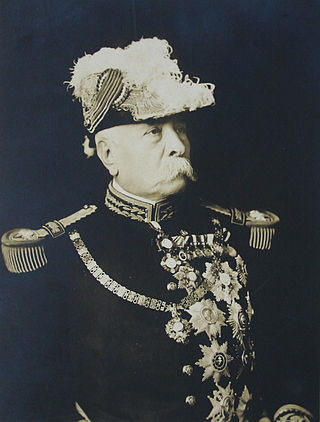
José de la Cruz Porfirio Díaz Mori, known as Porfirio Díaz, was a Mexican general, politician and later dictator who served seven terms as President of Mexico, a total of 31 years, from 28 November 1876 to 6 December 1876, 17 February 1877 to 1 December 1880 and from 1 December 1884 to 25 May 1911. The entire period from 1876 to 1911 is often referred to as the Porfiriato, and has been characterized as a de facto dictatorship.

Coatzacoalcos is a major port city in the southern part of the Mexican state of Veracruz, mostly on the western side of the Coatzacoalcos River estuary, on the Bay of Campeche, on the southern Gulf of Mexico coast. The city serves as the municipal seat of the municipality of the same name. The city had a 2020 census population of 212,540, making it the third-largest city in the state after Veracruz and Xalapa. The municipality covers a surface area of 471.16 km2 (181.916 sq mi) and reported a population of 310,698 persons. The municipality population in 2015 was 319,187 a decrease of 9% over 2020.

The Isthmus of Tehuantepec is an isthmus in Mexico. It represents the shortest distance between the Gulf of Mexico and the Pacific Ocean. Before the opening of the Panama Canal, it was a major overland transport route known simply as the Tehuantepec Route. The name is taken from the town of Santo Domingo Tehuantepec in the state of Oaxaca; this was derived from the Nahuatl term Tēcuāntepēc.

Tehuacán is the second largest city in the Mexican state of Puebla, nestled in the southeast of the valley of Tehuacán, bordering the states of Oaxaca and Veracruz. The 2010 census reported a population of 248,716 in the city and 274,906 in the surrounding Tehuacán municipality, of which it serves as municipal seat. The municipality has an area of 390.36 km².
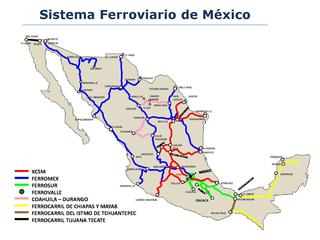
Mexico has a freight railway system owned by the national government and operated by various entities under concessions (charters) granted by the national government. The railway system provides freight and passenger service throughout the country, connecting major industrial centers with ports and with rail connections at the United States border. Passenger rail services were limited to a number of tourist trains between 1997, when Ferrocarriles Nacionales de México suspended service, and 2008, when Ferrocarril Suburbano de la Zona Metropolitana de México inaugurated Mexico's first commuter rail service between Mexico City and the State of Mexico. This is not including the Mexico City Metro, which started service in 1969.
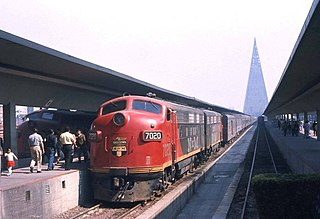
Ferrocarriles Nacionales de México was Mexico's state owned railroad company from 1938 to 1998, and prior to 1938, a major railroad controlled by the government that linked Mexico City to the major cities of Ciudad Juárez, Nuevo Laredo and Matamoros on the U.S. border. The first trains to Nuevo Laredo from Mexico City began operating in 1903.
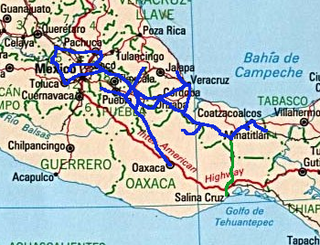
The Ferrocarril del Sureste, commonly known by the syllabic abbreviation Ferrosur, is a railway that serves the southeastern regions of Mexico. The company was formed in 1998 following the privatization of Mexico's railways. Ferrosur won the concession to operate the southeastern railway. This includes the line between Mexico City and Mexico's busiest Gulf of Mexico/Atlantic Ocean port at Veracruz. Grupo México has owned the company since 2005 and there are long-delayed plans to merge it with the company's other railway, Ferromex.

The Interoceanic Railway of Mexico was one of the primary pre-nationalization railways of Mexico. Incorporated in Great Britain in 1888 to complete an unfinished project and compete with the Mexican Railway, it completed a 3 ft narrow gauge main line from Mexico City to Veracruz in 1891. Branches included Mexico City to Puente de Ixtla, Puebla to Cuautla, Atencingo to Tlancualpicán, and a cutoff between Oriental and Santa Clara. Through subsidiary Mexican Eastern Railroad, the Interoceanic acquired a branch from San Marcos to Teziutlán in 1902, and in January 1910 it began operating the Mexican Southern Railway from Puebla to Oaxaca under lease. The Mexican government acquired control of the Interoceanic in 1903, and subsequently sold it to the National Railroad of Mexico in exchange for ownership of that company.

The Ferrocarril del Istmo de Tehuantepec(Ferrocarril del Istmo de Tehuantepec, S.A. de C.V.), also known as Tren Interoceánico, Line Z, Ferrocarril Transístmico or simply Ferroistmo, is part of the Interoceanic Corridor of the Isthmus of Tehuantepec, owned by the Mexican government, that crosses the Isthmus of Tehuantepec between Puerto Mexico, Veracruz, and Salina Cruz, Oaxaca. It is leased to Ferrocarril del Sureste FERROSUR.
Demetrio Vallejo was a railroad worker and union activist from Tehuantepec, Oaxaca, Mexico. Vallejo began working as a railroad employee in 1928, later joining the Partido Comunista Mexicano (PCM) in 1934. Vallejo was eventually promoted to Regional Director of the PCM in Oaxaca, however later expelled in 1946. In 1946, Vallejo joined the Unified Socialist Action and later the Mexican Worker-Peasant Party (Spanish: Partido Obrero-Campesino Mexicano at its founding in 1950. Vallejo was a primary leader of the Mexican railroad strikes of 1958–59.

The National Railroad of Mexico was one of the primary pre-nationalization railways of Mexico. Incorporated in Colorado in 1880 as the Mexican National Railway, and headed by General William Jackson Palmer of the Denver and Rio Grande Railway, it completed a 3 ft narrow gauge main line from Mexico City to Nuevo Laredo in September 1888 after an 1887 reorganization as the Mexican National Railroad. At its north end, the Texas Mexican Railway, owned since 1883, ran east from Laredo to the Gulf of Mexico at Corpus Christi; a second Gulf connection was completed in 1905 through a branch from Monterrey to Matamoros. Other branches included a cut-off from Mexico City through Querétaro to Celaya and an incomplete Pacific extension from Acámbaro to Uruapan. In 1886 the railway commissioned Abel Briquet to take a series of photographs, which provide documentation of the railways at that time.

Ferocactus latispinus is a species of barrel cactus native to Mexico.

Events in the year 1836 in Mexico.
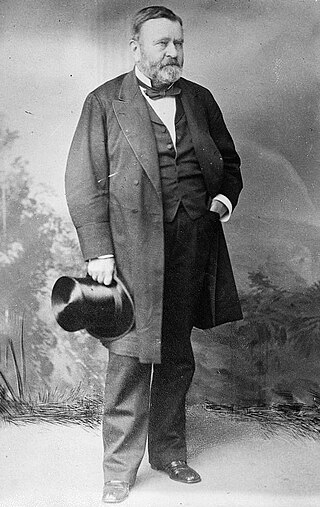
After eight years in the presidential office during Reconstruction, Ulysses S. Grant looked forward to retirement from public life. When his second term in office ended in March 1877, Grant had gained weight, while he desired to travel the world and visit his daughter in Scotland. Grant began his post-presidential life with a two-year tour that took him and his wife and entourage around the world.
Events in the year 1998 in Mexico.
Events in the year 1999 in Mexico.
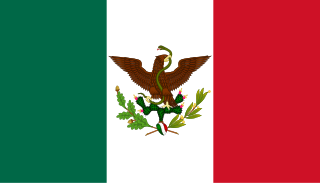
The Restored Republic was the era of Mexican history between 1867 and 1876, starting with the liberal triumph over the Second French Intervention in Mexico and the fall of the Second Mexican Empire and ending with Porfirio Diaz's ascension to the presidency. It was followed by the three-decade dictatorship known as the Porfiriato.

The Interoceanic Corridor of the Isthmus of Tehuantepec, abbreviated as CIIT, is a trade and transit route in Southern Mexico, under the control of the Secretariat of the Navy, which connects the Pacific and Atlantic Oceans through a railway system, the Ferrocarril del Istmo de Tehuantepec, for both cargo and passengers, crossing through the Isthmus of Tehuantepec. This project also consists on the modernization and growth of local seaports, particularly the ports of Salina Cruz (Oaxaca) and Coatzacoalcos (Veracruz), and of the Minatitlán oil refinery and the Salina Cruz oil refinery. In addition, it plans to attract private investors through the creation of 10 industrial parks in the Isthmus area, as well as two other parks in Chiapas. The project has the goal of developing the economy and industry of the Mexican South through encouraging economic investment, both national and international, and facilitate commerce and transportation of goods internationally.
















